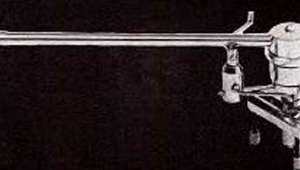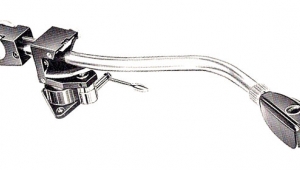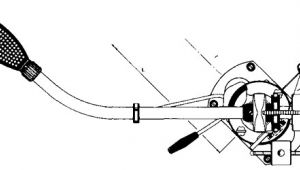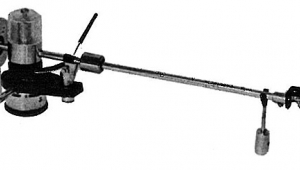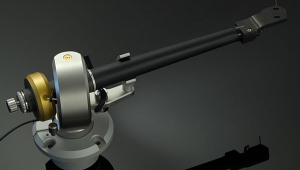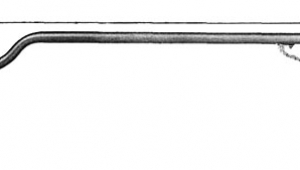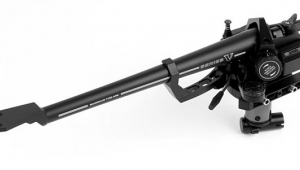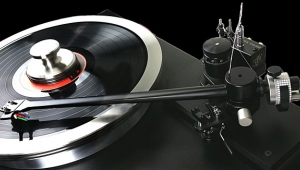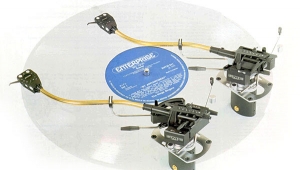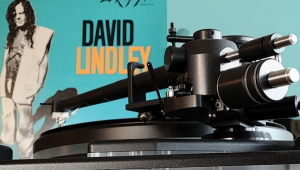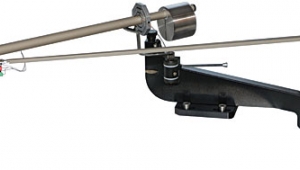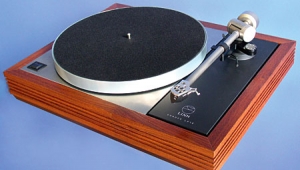| Columns Retired Columns & Blogs |
Graham Engineering Phantom B-44 tonearm
The Graham Engineering 1.5 tonearm, originally introduced in 1990, was a thoughtfully executed design that logically addressed all of the basics of good tonearm performance—geometry, resonance control, rigidity, dynamic stability—with effective, sometimes ingenious ideas, while providing exceptional ease and flexibility of setup. Over time, designer Bob Graham came up with ways to significantly improve the 1.5's performance, including the replacement of its brass side weights with heavier ones of tungsten, an improved bearing with a more massive cap, various changes in internal wiring, a far more rigid and better-grounded mounting platform, and a new, sophisticated ceramic armwand. (The original wand had hardly been an afterthought: its heat-bonded, constrained-layer-damped design consisted of an inner tube of stainless steel and an outer tube of aluminum.) The arm's name changed from the 1.5 to the 1.5t (tungsten), then the 1.5t/c (ceramic), and on to the 2.0, 2.1, and 2.2.
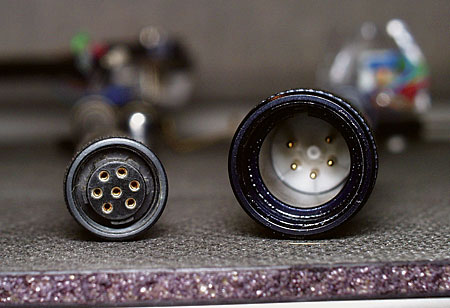
Graham 2.2 armwand (left) versus Phantom armwand (right).
Each upgrade changed the arm's sonic performance for the better, mostly in terms of low-frequency weight, solidity, and extension. Even critics of the 1.5's sound gave it top marks for parts and build quality, which is hardly surprising—Bob Graham is a big admirer of SME and its founder, Alastair Robertson-Aikman. (For an outstanding overview of the original Graham 1.5, see Dick Olsher's review in the August 1991 Stereophile, Vol.14 No.8.)
The original arm's detractors complained mostly of its lack of deep bass. Bob Graham responded that he'd paid particular attention to reducing the amplitude of the arm/cartridge combination's inevitable low-frequency resonant peak by carefully tuning and decoupling the counterweight, and that some listeners were mistaking the result for an absence of deep bass. Graham also rightfully pointed out the difference between the 1.5's nimble, detailed, well-textured bass and the bloated bottom end of some of the competition's arms. Still, his later upgrades of the 1.5 focused on and improved the arm's bottom-end performance. Clearly, the detractors had been on to something: the original 1.5 was somewhat meek in the bottom end. The Model 2.2 retained the 1.5's attractive bass qualities while dramatically improving the original's weight and extension.
The original 1.5 offered impressive overall performance and was particularly adept at resolving inner detail. I'll never forget the first album I played after installing the 1.5: Joni Mitchell's Court and Spark. The arm revealed, for the first time in my listening experience, the dimensions of the isolation booth in which Mitchell had recorded her lead vocals. This was not a musically important detail, but it indicated the arm's exceptional powers of resolution.
Every tonearm design, be it traditional gimbaled bearing, unipivot, duo-pivot, constrained unipivot, or the so-called linear tracker (tangential tracker is more accurately descriptive, considering the design's goal), has inherent advantages and limitations. The designer's job, once he or she has chosen the means by which the stylus will be moved across and through the record grooves, is to maximize the strengths and minimize the weaknesses of that choice.
When Bob Graham finished v.2.2 and realized that his original design could be taken no further, he set about designing what he thought would be an even better arm. After two years of work, the Phantom B-44 has arrived ($4275). Like the original 1.5, the Phantom's parts quality and fit'n'finish rival those of any tonearm made anywhere in the world, and surpass most.
You have to examine the Phantom yourself to appreciate the differences between it and the original. There are conceptual and mechanical similarities between them, but while the Phantom superficially resembles the original 1.5, it is an entirely new tonearm. Graham carefully thought through his original design and concluded that its basic concepts were still sound—the new arm differs from the old mostly in Graham's execution of those concepts and in terms of sheer scale, along with the primary invention of magnetic stabilization. Graham redesigned the arm literally from the inside out, beginning with the pivot and working outward, part by part. Overall, the Phantom is bigger and more massive. The only part remaining from the 1.5 is the butt end: the DIN jack block.
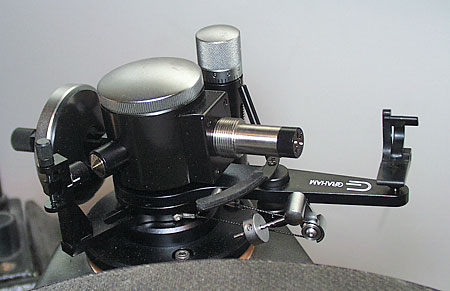
Phantom without armwand, showing stainless steel support stub.
Like the 1.5, the Phantom uses an inverted bearing fixed to a threaded top cap that screws into the cup assembly, which also makes a convenient well for the damping fluid. The bearing itself is a small-radius (>0.005") tungsten-carbide tip riding in a 0.01"-radius sapphire cup. The Phantom has a threaded post for adjusting the vertical tracking angle (VTA) that's similar to the 1.5's, but bigger, beefier, and smoother.
The Phantom also has a removable, Lorzig-ceramic armwand similar to the 1.5's, but far more rigid, precise, and easier to replace. The armwand has a wider diameter and is progressionally extruded to suppress standing waves, and the tube features a glossy, proprietary overlay of glass that damps vibrations and looks better than the 1.5's tube. The new connection mechanism is far more robust and secure, with a protruding post of stainless steel that fits deeply into the wand before being screwed in and held under tension at two points. The clearance between post and wand is said to be about 0.001"; lateral play is nil.
The electrical contact pins are of high-copper-content phosphor bronze, to both maintain tension and avoid deformation. The wand's internal wiring has been improved from the 2.2's, and is now precision-twisted by machine and layered to isolate the channels from each other, before being encased in a silicone jacket. The entire package is then inserted as a unit into the wand, with the result of another level of damping.
Gone are the outriggers that helped stabilize the 1.5 during play and kept the arm's center of gravity below the pivot point to create a stable balance system, much as in a laboratory balance scale. This good design is typical of most arms, but it creates a condition wherein the arm, when deflected, tries to return to a resting position (as when trying to track a warped record) instead of following the warp. As a result, the cantilever is deflected, as tracking-force consistency cannot be maintained and the cartridge generator system's linearity is compromised.
The reason you are advised to measure vertical tracking force (VTF) at the record surface and not above it is because most tonearms are stable-balanced. The higher above the record surface you lift the arm, the more force it will exert trying to get back down to its rest position. The farther above the record surface you measure VTF, the greater it will be compared to what you'll measure at the record surface, which is where you want it to be accurate. If you have an accurate VTF gauge, measure your arm's VTF as close to the platter surface as possible, and then again with the gauge sitting on a thick magazine to lift it above the platter. The reading will be significantly higher the farther you raise the gauge, as Bob Graham demonstrated to me with his 2.2.
The Phantom's tracking force remained constant at all heights. That's because the arm is neutrally balanced—the system's center of gravity is at the pivot point, not above or below it. The arm wants to remain wherever it is in the vertical dimension, rather than try to fight its way back to a specific rest position. Graham says that the amount of mass used in the design, and especially the distribution of that mass, contribute to the arm's stability while playing an LP.
- Log in or register to post comments
